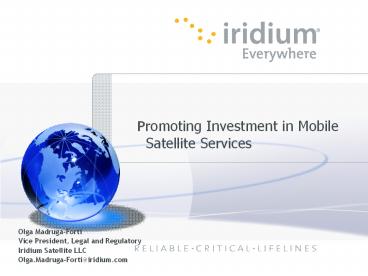Promoting Investment in Mobile Satellite Services - PowerPoint PPT Presentation
Title:
Promoting Investment in Mobile Satellite Services
Description:
Villages with ICTs and establish community access points. Universities, colleges, secondary ... Provide interoperability between disparate systems and networks. ... – PowerPoint PPT presentation
Number of Views:30
Avg rating:3.0/5.0
Title: Promoting Investment in Mobile Satellite Services
1
Promoting Investment in Mobile Satellite
Services
Olga Madruga-Forti Vice President, Legal and
Regulatory Iridium Satellite LLC Olga.Madruga-Fort
i_at_iridium.com
2
Satellite Connectivity Plays Essential Role in
Achieving WSIS Targets by 2015
- Targets include Connecting
- Villages with ICTs and establish community access
points - Universities, colleges, secondary schools and
primary schools with ICTs - Scientific and research centers with ICTs
- Public libraries, cultural centers, museums, post
offices and archives with ICTs - Health centers and hospitals with ICTs
- All local and central government departments and
establish websites and e-mail addresses
3
Satellite Connectivity is Critical in Times of
Disasters and Emergencies
- Always available even though terrestrial
infrastructure is damaged, destroyed or
overloaded - Interconnect widely distributed networks during
times of disasters - Provide interoperability between disparate
systems and networks. - Can warn of impending disasters
- Uniquely appropriate for first responders
4
Critical Role of Regulator
- Commercial investment is based on analysis of the
opportunity, the costs involved and legal
possibilities and requirements. There are three
key roles of the regulator. - 1. POLICY. Regulators create opportunities and
inform the public. Policies should exist, be
transparent and readily identifiable. - 2. COSTS. Regulators have a significant role in
determining the cost of providing service.
Spectrum fees, and all local requirements sum up
by country to affect feasibility. The higher the
cost, the less likely an investment will occur,
particularly where market for services is small - 3. ADJUDICATION. Regulators also affect timing
and rollout in adjudicating applications and
authorizations. - Key is promoting competition, transparency in
regulatory process, light-handed regulation where
possible
5
Iridium Provides Global Coverage
- Constellation of 66 Low Earth Orbit (LEO)
satellites - 6 planes of 11 satellites
- Polar orbits provide at 780 km altitude
- 100 global coverage
- Inter-satellite links are key differentiator
- Multiple spares in orbit
6
Barriers to Satellite Connectivity
- Service Barriers
- No policy.
- Approval required for satellite system in every
country, not just the distributors - High application fees, licensing fees,
infrastructure requirements - Lengthy approval process, local incorporation
requirements - Equipment Barriers
- Difficulty in obtaining type approval.
- Absence of coordination between different parts
of the government (e.g., customs and the
regulatory authority) - Results??
- Satellites will bypass the market.
- Users left unserved.
7
Facilitating Market Access and Investment
- Light-touch regulation Open Skies policy
- Minimum necessary to achieve government
objectives of protecting public safety and
managing scarce resources - Simplified application process for foreign
satellite systems - Focus on the service provider (distributor) and
not on infrastructure - Regulations should be technology neutral
- Accommodate the maximum number of satellite
systems possible - Adopt application fees and annual fees that
reflect the actual cost of regulation - Rely on international coordination process at ITU
- If satellite is operational, it is coordinated
- Blanket licensing of terminals and other
terrestrial equipment
8
International and Regional Efforts to Facilitate
Investment
- GMPCS MOU
- Blanket or class licensing for handsets, mutual
recognition of type approval - Elimination or reduction of customs requirements
for handsets - Allow MSS subscribers to carry and use their
handsets in-country - Tampere Convention
- Facilitate provision of prompt communications
assistance during times of disaster and
emergencies - Covers both installation and operation of
communications systems - Addresses regulatory barriers in advance
- Licensing
- Use of frequencies and equipment
- Import of equipment
- Movement of personnel
9
Regional Efforts
- European Union
- Granted a pan-European license for S-band
- Eliminated individual country type approvals of
satellite and other telecom terminals - Introduced harmonized equipment standards
- CITEL Recommendation 20 (VIII-06)
- Consider the adoption of procedures that
facilitate the free circulation and
implementation of GMPCS satellite system
terminals for when Administrations consider them
needed - Notify the CITEL Exec Secretary of authorized
systems and terminals, including contact points
for posting on CITEL website
. .
10
Country-Specific Examples of Light-Touch
Regulation
- Satellite system does not require license
- Focus on distributor of service
- No limits on number of licensees or foreign
ownership. - Observe ITU coordination of frequencies.
- Singapore
- Service-based Operator License
- No application fee
- Annual fee of US3,384
- Uganda
- Public Service Provider License
- Application fee US2,500
- Annual fee US10,000 plus 1 levy on gross
annual revenue in country - Uruguay
- Low fees, which are transparent and identifiable
- Speedy adjudication.
11
Conclusions
- To promote investment in satellite services,
regulators should adopt a light touch - Eliminate unnecessary regulation
- Streamline regulations for satellite services
- Regulators should work through regional and
multilateral fora to harmonize regulations and
standardize licensing requirements - Regulators should coordinate with other
government agencies to promote ease of entry and
reduced costs for satellite terminals and other
necessary equipment































